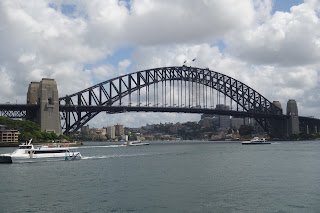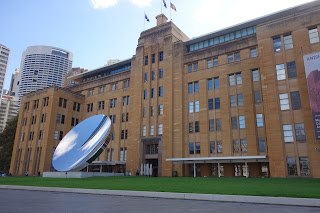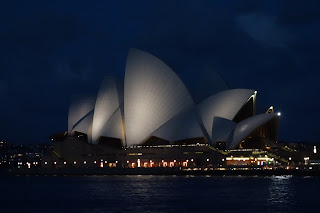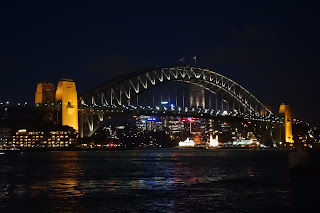Sydney is the state capital of New South Wales and the most populous city in Australia, although Melbourne is close on its heels. Currently Sydney has a population of approx. 4.7 million people and people who live in Sydney are called Sydneysiders.
The site of the first British colony in Australia, Sydney was established in 1788 at Sydney Cove by Arthur Phillip, commodore of the First Fleet, as a penal colony. The city is built on hills surrounding Port Jackson which is commonly known as Sydney Harbour, where the iconic Sydney Opera House and the Harbour Bridge feature prominently.
There is so much to tell you about Sydney - but rather than bore you with a mini-book (or maybe no so 'mini') I'll just try and tell you little bits and pieces as I go along.
I am incredibly fortunate that I have a friend to stay with here who lives almost right in the centre of Sydney - right beside Hyde Park - and no more than a 2 kms walk to the Opera House. Hyde Park is the oldest public parkland in Australia. It is a 16.2 hectares park in the central business district (CBD) of Sydney and it is named after the original Hyde Park in London. The centrepiece of Hyde Park is the Archibald Fountain. The fountain was donated by J.F. Archibald in 1932 in honour of Australia's contribution to World War I in France.
In the background you can see Sydney Tower. Sydney Tower is Sydney's tallest free-standing structure, and the second tallest in Australia. It is also the second tallest observation tower in the Southern Hemisphere. The tower stands 309m above the Sydney CBD and as you can imagine, it is a great tourist attraction.
Hopefully over the next few days I'll be able to spend a bit more time in Hyde Park as it is quite beautiful - but today I had a goal in mind... to get to the harbour.
And here it is - the Sydney Harbour Bridge exactly as it looked to me when it came into sight.
The Sydney Harbour Bridge is a steel through arch bridge across Sydney Harbour that carries rail, vehicular, bicycle and pedestrian traffic between the Sydney CBD and the North Shore. The bridge is nicknamed "The Coathanger" because of its arch-based design. The bridge was designed and built by British firm Dorman Long and Co Ltd of Middlesbrough and opened in 1932. The bridge's design was influenced by the Hell Gate Bridge in New York. It was the world's widest long-span bridge, at 48.8 meters wide, until construction of the Port Mann Bridge in Vancouver. It is also the fifth longest spanning-arch bridge in the world, and it is the tallest steel arch bridge, measuring 134 metres from top to water level. Until 1967 the Harbour Bridge was Sydney's tallest structure.
And the second iconic structure in Sydney - the Sydney Opera House.
The Sydney Opera House is a multi-venue performing arts centre here in Sydney. It was conceived and largely built by Danish architect Jorn Utzon, opening in 1973 after a long gestation that had begun with his competition-winning design in 1957. The building houses multiple performance venues and is among the busiest performing arts centres in the world, hosting over 1,500 performances each year attended by some 1.2 million people. In 2007, the Sydney Opera House was made a UNESCO World Heritage Site. It is one of the 21st century's most distinctive buildings and one of the most famous performing arts centres in the world.
Unfortunately the weather forecast for the next few days here in Sydney seems to include a lot of rain, so I thought I'd take advantage of the fact it wasn't currently raining and take a Harbour Cruise. These next photos were all taken while I was cruising Sydney Harbour.
Port Jackson, containing Sydney Harbour, is the natural harbour of Sydney. Widely considered to be one of the world's finest harbours, it is well-known for its beauty. Its entrance is between North and South Heads, where naval and military stations are located. The location of the first European settlement in Australia, the harbour has continued to play a key role in the history and development of Sydney. The city itself lies on the southern shore, while the Northern Suburbs lie on the northern shore; which are linked by several bridges, the most famous one being the Harbour Bridge.
The first recorded European discovery of Sydney Harbour, was by Lt. James Cook in 1770 - Cook named the inlet after Sir George Jackson, (one of the Lord Commissioners of the British Admiralty, and Judge Advocate of the Fleet). Eighteen years later, in 1788, after arriving at Botany Bay (which is about 10 kms south of Sydney Harbour), Governor Arthur Phillip took a longboat and two cutters up the coast to examine Cook's Port Jackson. Phillip first stayed over night at Camp Cove, then moved down the harbour, landing at Sydney Cove and then Manly Cove before returning to Botany Bay. Phillip returned to Sydney Cove in H.M. Armed Tender Supply on 26 January 1788, where he established the first colony in Australia, later to become the city of Sydney. In his first dispatch from the colony back to England, Governor Phillip noted that "...we had the satisfaction of finding the finest harbour in the world, in which a thousand sail of the line may ride in the most perfect security..."
Sydney's CBD which, for a city of this size, really isn't that big.
Geologically, Port Jackson is a drowned river valley, or ria. It is 19 km long with an area of 55 km². The estuary's volume at high tide is 562 million cubic metres. The perimeter of the estuary is 317 kilometres. The harbour contains many bays - 62, I think - and it's these bays that house many Sydney suburbs. Additionally, there are several islands located within the harbour.
After the harbour cruise I met up with my friend and piggy-backed on an invitation she had to attend an educators' evening at the Museum of Contemporary Art (MCA). It is housed in the Art Deco-style former Maritime Services Board Building and is solely dedicated to exhibiting, interpreting and collecting contemporary art, both from across Australia and around the world. The current exhibition is by Anish Kapoor, his first major exhibition in Australia. Sky Mirror is the work set up outside on the lawn,
and these are just a few photos I took of the exhibit inside. Obviously photos can't possibly do it justice ... it is an amazing exhibit.
And to end the day, an attempt at a couple of photos of these two wonderful structures again.
The entrance of the harbour, looking out to the Tasman Sea.
South Head - of the harbour entrance.
North Head - of the harbour entrance.
Cruise ships are frequent visitors in Sydney Harbour, and right now there are three anchored here. You saw the first one in my first photo of the Harbour Bridge, and here is the second.
Sydney also has a Luna Park (as did Melbourne), an amusement park constructed at the foot of the Sydney Harbour Bridge in 1953.
And this is the third cruise ship, docked in Darling Harbour which is one of the bays within Sydney Harbour.
and these are just a few photos I took of the exhibit inside. Obviously photos can't possibly do it justice ... it is an amazing exhibit.
And to end the day, an attempt at a couple of photos of these two wonderful structures again.





































No comments:
Post a Comment